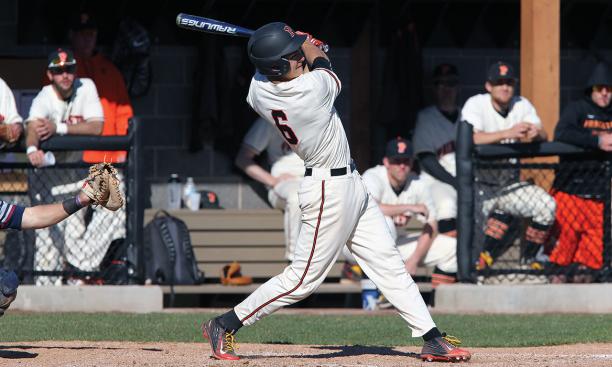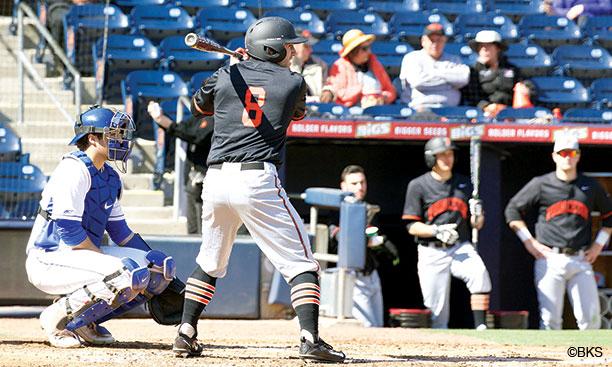
It is 7:30 on a cold Friday night in early December, and the basement level of Jadwin Gym has been turned into a physics laboratory. In the poorly lit space, amid the ever-present hum of the building’s heating units, two undergrads are conducting projectile-motion experiments. Over and over again, they launch spheres into the fraying black netting that hangs from the ceiling, 40 feet above their heads. “I want the launch angle to be higher,” one says. “How can we do that while maintaining the same exit velocity?” the other responds. Down here in the depths of Jadwin, these scientists do not wear goggles or lab coats. Instead, they wield baseball bats.
This is the baseball training regimen of Max West ’19 and Chris Davis ’20, who have sought to improve their performance by changing their swings to better account for the physics of hitting. Over the past seven months, they have worked tirelessly to overhaul their swings, conducting training sessions that are half science experiment, half conventional batting practice. And the changes are working. Buoyed by their data-driven approach, West and Davis have become key offensive players for a Princeton team that is looking to claim its second Ivy League title in three years.
Davis, the Tigers’ primary leftfielder and leadoff hitter, first realized he had a problem when he was training in his native Connecticut alongside a major-league player in a facility that measured the speed at which the ball leaves the bat (exit velocity). The son of ESPN College GameDay host Rece Davis, the younger Davis had been around high-level sports his entire life. Working out next to a pro, he was anything but wide-eyed. Rather, he was confused. He noticed that his 96-mph exit velocity off a batting tee was just 2 mph slower than that of his major-league counterpart. “If I’m hitting the ball almost as hard as this guy,” Davis wondered, “why is he in the big leagues and I’m struggling at the college level?”

West, who arrived on campus as an unheralded walk-on and is now the Tigers’ starting catcher, was similarly frustrated. A native of Singapore, he had forged a relentless work ethic during his time as a combat diver in his country’s navy. Even though he had never caught before coming to Princeton, West quickly transformed himself into an elite defensive catcher, throwing out 37 percent of attempted base stealers in his first two seasons. Offensive progress, however, did not come nearly as easily. “I had been working as hard as I could to hit the ball harder,” he said. “But I’d never really gotten the results I had hoped for in games, even though I felt my swing was fine.”
Enter the physics of hitting: “All of a sudden I stumbled upon this new world of analytical hitting, where I found out that exit velocity and launch angle were the two most important things to hitting success,” West said, referencing the slew of research that has come out in the past few years concerning batted-ball outcomes. According to leading baseball physicist Alan Nathan *75, a professor emeritus at the University of Illinois, the ideal batted ball is not only hit hard, but also hit in the air at a launch angle between 10 and 20 degrees to maximize batting average and between 25 and 35 degrees to maximize the potential for a home run. West and Davis were fascinated by the research. “If I hit a 105 mile-per-hour ground ball, I might hit into a double play,” Davis explained, and then smiled. “But if I hit it 105 miles per hour at a 25-degree launch angle, the only guy who is going to make a play on it is a fan beyond the right-field fence.”
While the concepts were relatively easy to understand for West and Davis, the process of overhauling their swings to maximize exit velocity within the ideal launch angle proved far more challenging. Their biggest obstacle involved another physics concept: swing plane. In their youth, both had developed downward swing planes, which were ill-suited to creating the sort of elevated hard contact that most reliably leads to success. They needed to engineer their swings with an upward plane, to ensure that their hardest contact ended up on the outfield grass or over the fence. “Our training sessions were a constant process of conversation, watching video of major leaguers, trial and error, and small steps toward the common end result we both wanted: hitting the ball harder and higher,” West said.
After seven months, the long nights in the Jadwin laboratory are paying off. West and Davis each began with career-best starts for the Tigers, consistently driving the ball in the air and out of the reach of the infielders who once turned their hardest-hit balls into outs.
“When I get in the box in a game, I know I’ve put in all of this technical and data-driven-approach work in practice,” West explained. “And that gives me a lot of confidence to just go out and compete.”
